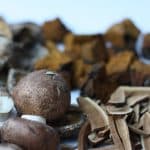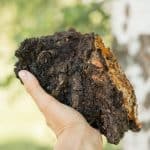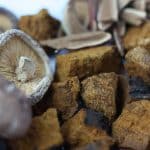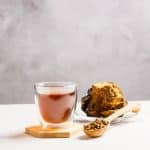Thousands of species of mushrooms have been discovered over the years, and they possess a number of properties beneficial to your health and wellbeing in general. One species, in particular, has been noted for many health benefits and nutrients, making it known as “the King of Mushrooms”.
This impressive superfood is Inonotus obliquus, otherwise known as Chaga mushroom. This species contains powerful antioxidants which helps support immune health and promotes anti-aging and youth.
Historically used for its medicinal purposes for thousands of years, chaga has now taken form as a natural supplement found in a powdered or capsule form, which may help to deliver various health benefits that support general well-being. So, what exactly is chaga mushrooms?.
What Is Chaga Mushroom?
Chaga is a mushroom that grows naturally on the sides of tree trunks, especially Birch trees, which are found in northern hemisphere cold weather. Chaga has a look like a big black mass, or char, with an internal color that is flaming orange. Although unappetizing in its looks, Chaga has a number of powerful benefits which have been proven through numerous scientific studies on everything from anti-aging benefits to improving and strengthening the immune system. Chaga is also known for having some of the highest levels of antioxidants of any adaptogen or “superfood”
Where Does Chaga Come From?
Wild chaga comes from cold temperature climates, it has been used medicinally throughout Russia, Japan, China, Korea, Canada, Alaska, and northern America for centuries to support immune health. Chaga is also found in western/southern Europe and southeast Asia.
How Has Chaga Been Historically Used?
Historically, Chaga was used in popular medicine during the 12th century as a health drink via it’s use in tea. Chaga mushrooms cannot be consumed in their natural raw-state, however, after extracting nutrients from the charcoal-like mushrooms, chaga can be used in tea’s to help support the body’s natural inflammation response and to support the immune system. Chaga is currently still commonly used in teas and other beverages. It can be consumed in a powdered form, or taken in capsules.
Potential Medicinal Properties of Chaga Mushrooms
Chaga is an adaptogenic mushroom, one of the most commonly used nature medicines of ancient China. People from some regions in Siberia used the mushroom by applying it on their skin, breathing it or drinking chaga tea. Nowadays, many people think that chaga is one of the most incredible superfoods available in the market, and with good reason.
Although many biological activities of chaga are yet to be completely studied, the results from the present studies are promising. Chaga has been shown to:
- support the immune system
- reduce inflammation
- fight cancer
- lower cholesterol
- lower blood pressure
- improve skin and hair quality
How to Use Chaga
After learning about chagas numerous medicinal properties, you might be willing to give this mushroom a shot for yourself.
Fortunately, there are plenty of ways you can do that.
You can opt for the powdered, capsule, sliced mushrooms, or you can eat them through fortified food options.
Chaga Mushroom Powders
Chaga Powder is the most popular option to consume these mushrooms. There are many options out there when it comes to powdered chaga mushrooms. However, they are not all the same quality, so you might not be getting all of the benefits of chaga if you are getting the powder from a lower-quality brand.
Chaga Capsule Products
Chaga capsules are simply the powdered substance, pressed into capsules. They are a great option if you are already taking lots of vitamins every day, or you are not into the smell of mushrooms. However, you should opt for another option if you forget to take the supplements daily, since you wonat get the full benefits that chaga has to offer.
Making Chaga into Tea
This option is perfect for anyone who likes to enjoy a cup of tea every day. However, you will get just the water-soluble compounds found in Chaga. You can make Chaga Mushroom Tea by mixing the chaga powder into warm water, following a process similar to making any other herbal tea.
Additional Resources:















